Open guard retention principles: How to develop an unpassable guard
Here are some important principles to understand for recovering guard and defending against open guard passes. These would apply to preventing guard passes like the leg weave, various smash passes, knee slice/cut/slide, toreando, over/under, and pretty much anything else.
Using your free leg
When one leg is in trouble (getting pinned or dragged), you usually need the other leg to save you by pushing on the opponent as you pull your vulnerable leg back. Don’t neglect the pull part. That’s equally important as the push.
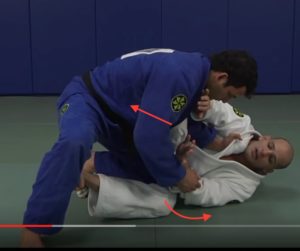
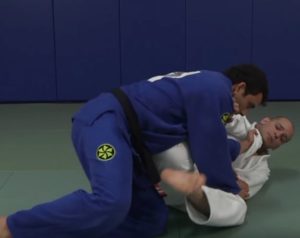
Therefore:
- Keep your knees close to your chest in general. It’s ok to extend one to push away the opponent, but never extend both legs. Think of how a boxer keeps his hands close to his head most of the time, and extends one or the other to punch, but never both. When both are extended, there is no potential to push the opponent away.
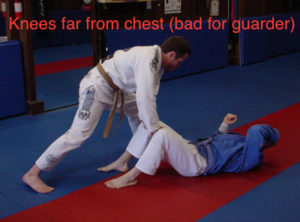
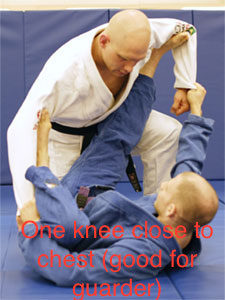
- Since you want to keep your knees close to your chest, if your opponent pins your feet to the ground, sit up to move your chest closer to your knees.

- Never allow your knees to come too close to each other. If they get pinned together, one won’t be able to help the other.
Facing the opponent and maintaining the angle
If your opponent is passing to your right, you want your hips and knees to be facing to the right. If your hips and/or knees are facing left, there’s no way your left leg can help defend. So, even if he manages to drag your leg to your left, you need to point your knees to the right, and this will allow you to bring your left leg into the game.
If your head is at 12 o’clock and your feet are at 6 o’clock, you want to keep your opponent’s feet at 6 o’clock. If he starts running around to cut an angle on you, you need to spin to keep your feet pointed at his feet.

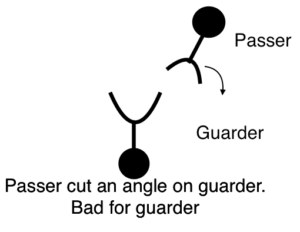

Pushing the head
Your opponent wants to pass the guard by getting to side control. His head will be on one side of your body and his legs will be on the other. You want the opposite. If he’s passing with his legs on your right, you want to push his head to your right. When you do this, it will be very easy to square up with him.
Here’s an example of this from Great Grappling, ‘Half Guard Pass Defense Push on Face’:
and here is The Grappling Academy:, ‘The BEST Ways to Protect Your Guard – Principle 5 of 6’, which talks a lot about head pushing.
Points of contact / lines of defense
You always want to have 4 points of contact with the opponent if you can. Two hands, two feet. As you transition between guards, it’s inevitable that you’ll have to drop that number to 3 sometimes, but try not to go lower. Think of rock climbing. Your opponent will constantly be trying to remove your points of contact by breaking your grips, and pushing and pulling your legs. When he succeeds in removing a point of contact, immediately move it somewhere else on his body. If your limb is just hanging in the air, not able to push or pull on anything, it’s useless.
If your opponent gets past your feet, maybe you can still use your knees. If they get past your hands, maybe you can still use your elbows/forearms. If they get past your knees / elbows, maybe you can use your arms or legs to bump them forward from behind.
This video from Keenan Cornelius on the 8 lines of defense demonstrates this principle:
‘Keenan Cornelius Worm Guard Seminar in Kuala Lumpur’ goes deeper into the same principles:
And this one by Ryan Hall, ‘Ryan Hall – Defensive Guard, Strategy, Fundamentals, Building Walls, Sweeps & Submissons’
also talks about lines of defense:
Additional links:
This video by Xande Ribeiro demonstrates most of these principles, and I think is one of the best on this topic:
This series of videos by Ostap Manastyrski shows some defenses to common open guard passes.
Here’s Demian Maia on this topic:
This video by Brea Jiu-Jitsu breaks down Keenan Cornelius’s open guard game, and includes a lot on guard retention, which starts at about 16:20:
Episode 1 and 2 of the Martin Aedma Jiu-Jitsu show focus on open guard retention and are fantastic and well worth a watch. Be warned that they’re about an hour each.
This clip by Kit Dale on ‘Fundamentals for Open Guard in BJJ
‘ describes some fundamentals of open guard retention:
This clip by Bernardo Faria, ‘Guard Retention: How To Stop Your Guard From Getting Passed’, talks about staying tight, which would include keeping your knees close to your chest, or turning to the knees to avoid the pass.
For more from me on open guard retention, check my guard retention category on this blog:
http://bjjpressure.com/category/guard-retention/
Awesome article!
This is an amazing article. Thank you very much.